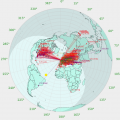jks
About
- Username
- jks
- Joined
- Visits
- 36,739
- Last Active
- Roles
- Member, Administrator, Moderator
- Points
- 670
Reactions
-
OpenWebRX [using a transverter/down-converter with the Kiwi]
-
v1.281: signal generator extension, audio FFT fixes
From the CHANGE_LOG file:v1.281 April 12, 2019 Add URL parameter "peak" to set spectrum peak hold mode (overrides last value saved in cookie) e.g. "&peak", or redundantly "&peak=1", but more usefully "&peak=0" Audio FFT: Allow URL parameter "no_wf" to be used in 4 and 3-channel modes, not just 8-channel mode. This is useful e.g. if you want to use the audio FFT to study the frequency response of the new de-emphasis filter in 20 kHz mode (3-channel mode) where you would otherwise never be given the audio FFT because there is no shortage of waterfall channels. Added missing window function to FFT. Fixed scale/waterfall click frequency in non-IQ modes. Added signal generator extension. When enabled replaces ADC input to audio/waterfall DDCs with a tunable RF signal source using the same FPGA DDS IP block used by the DDC mixers. WARNING: Be careful about drawing conclusions re Kiwi performance and possible bugs when using the sig gen. It reveals spurious responses in the waterfall/spectrum to a greater degree than if you just tune around with an antenna connected. But without detailed experimentation it can be difficult to know where the limitations are. Remember that the Kiwi is a carefully balanced compromise to get 4-channel mode to work (i.e. fit in the FPGA and have enough Beagle CPU cycles). So the DDSs, mixers, DDCs and FFTs are not perfect. Speaking of compromise, when considering FFTs it's important to understand this: https://en.wikipedia.org/wiki/Spectral_leakage -
v1.281: signal generator extension, audio FFT fixes
From the CHANGE_LOG file:v1.281 April 12, 2019 Add URL parameter "peak" to set spectrum peak hold mode (overrides last value saved in cookie) e.g. "&peak", or redundantly "&peak=1", but more usefully "&peak=0" Audio FFT: Allow URL parameter "no_wf" to be used in 4 and 3-channel modes, not just 8-channel mode. This is useful e.g. if you want to use the audio FFT to study the frequency response of the new de-emphasis filter in 20 kHz mode (3-channel mode) where you would otherwise never be given the audio FFT because there is no shortage of waterfall channels. Added missing window function to FFT. Fixed scale/waterfall click frequency in non-IQ modes. Added signal generator extension. When enabled replaces ADC input to audio/waterfall DDCs with a tunable RF signal source using the same FPGA DDS IP block used by the DDC mixers. WARNING: Be careful about drawing conclusions re Kiwi performance and possible bugs when using the sig gen. It reveals spurious responses in the waterfall/spectrum to a greater degree than if you just tune around with an antenna connected. But without detailed experimentation it can be difficult to know where the limitations are. Remember that the Kiwi is a carefully balanced compromise to get 4-channel mode to work (i.e. fit in the FPGA and have enough Beagle CPU cycles). So the DDSs, mixers, DDCs and FFTs are not perfect. Speaking of compromise, when considering FFTs it's important to understand this: https://en.wikipedia.org/wiki/Spectral_leakage -
Realtime frequency/mode change via the jks-prv/kiwiclient library?
Jim, let me know if you get kiwi_nc working. I got it running to the point of producing output but haven't tested it beyond that.
For Mac people, I just found this work by Chris yesterday: https://www.blackcatsystems.com/software/kiwiSdr-sound-client-virtual-audio-device.html -
Last Spectrum persists when all signals removed [fixed in v1.279]
v1.279 has improved spectrum filter options. In addition to the default IIR filter you can now select an MMA (modified moving average) and EMA (exponential moving average) filter or no filtering at all. There is also a new slider for the parameter associated with each filtering algorithm:
The URL parameter options sp= and spp= allow the filter and filter parameter to be preset in the URL. See http://kiwisdr.com/quickstart/index.html#id-user-tuneIIR: param = gain coefficient 0..1 (slower..faster) MMA: param = averaging size in samples (1..64) EMA: param = decay period (averaging size) in samples (1..64)
I implemented a minimum decay rate for the IIR filter. For various reasons the filtering is implemented after the waterfall colormap scaling. And with a more restricted colormap range (i.e. WF min slider less negative so no-signal waterfall area is black) the IIR filter would not decay for small signals as was observed.
There is also a new "GND" momentary button (i.e. click/touch and hold). This zeros (grounds) the waterfall/spectrum input data so you can see how the various spectrum filters decay under no-signal conditions.








